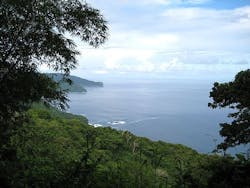A remote microgrid can play a crucial role on a far-flung island, as SolarCity shows today in unveiling a completed project 4,000 miles off the U.S. West Coast.
American Samoa courtesy of NOAA
The company installed a solar microgrid on the island of Ta’u in American Samoa. The microgrid’s “benefits are life changing for residents,” says Peter Rive, cofounder and chief technology officer, in a blog posted on SolarCity’s website.
The remote microgrid uses 1.4 MW of solar and 6 MWh of battery storage from 60 Tesla Powerpacks. The project replaces diesel generators with nearly 100 percent renewable energy.
Because of interruptions in diesel fuel shipments, the island is no stranger to power rationing and outages.
Rive quotes local resident Keith Ahsoon whose family owns a food store on the island: “I recall a time they weren’t able to get the boat out here for two months. We rely on that boat for everything, including importing diesel for the generators for all of our electricity. Once diesel gets low, we try to save it by using it only for mornings and afternoons. Water systems here also use pumps, everyone in the village uses and depends on that. It’s hard to live not knowing what’s going to happen. I remember growing up using candlelight. And now, in 2016, we were still experiencing the same problems.”
Remote microgrid cuts energy costs
Rive described the financial benefit to the island as substantial, factoring in the costs of the fuel and its transportation to the distant island. By using the microgrid, the island will cut the need for 109,500 gallons of diesel per year, according to SolarCity.
“Tau’s microgrid replaces diesel generators with more affordable solar energy, and is designed to optimize system performance and maximize savings,” Rive writes.
The American Samoa Power Authority will operate the remote microgrid for the island’s 600 residents. Project funding came from the authority, along with the Environmental Protection Agency and the Department of Interior.
“This is part of making history. This project will help lessen the carbon footprint of the world. Living on an island, you experience global warming firsthand. Beach erosions and other noticeable changes are a part of life here. It’s a serious problem, and this project will hopefully set a good example for everyone else to follow,” Ahsoon tells Rive.
The announcement of the new microgrid comes just one day after SolarCity and Tesla made official their merger in a filing before the U.S. Securities and Exchange Commission. SolarCity is now a wholly owned subsidiary of Tesla. Elon Musk, Tesla CEO, positioned the merger as a way to create a one-stop shop for consumers and businesses that want to purchase electric vehicles, solar panels and battery storage.
Read more about projects like this on the Microgrid Knowledge channel dedicated to remote microgrids.







